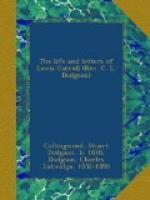He also told us he once dreamed an enormously long poem about fairies, which began with very long lines that gradually got shorter, and ended with fifty or sixty lines of two syllables each!
On October 17, 1859, the Prince of Wales came into residence at Christ Church. The Dean met him at the station, and all the dons assembled in Tom Quadrangle to welcome him. Mr. Dodgson, as usual, had an eye to a photograph, in which hope, however, he was doomed to disappointment. His Royal Highness was tired of having his picture taken.
During his early college life he used often to spend a few days at Hastings, with his mother’s sisters, the Misses Lutwidge. In a letter written from their house to his sister Mary, and dated April 11, 1860, he gives an account of a lecture he had just heard:—
I am just returned from a series of dissolving views on the Arctic regions, and, while the information there received is still fresh in my mind, I will try to give you some of it. In the first place, you may not know that one of the objects of the Arctic expeditions was to discover “the intensity of the magnetic needle.” He [the lecturer] did not tell us, however, whether they had succeeded in discovering it, or whether that rather obscure question is still doubtful. One of the explorers, Baffin, “though he did not suffer all the hardships the others did, yet he came to an untimely end (of course one would think in the Arctic regions), for instance (what follows being, I suppose, one of the untimely ends he came to), being engaged in a war of the Portuguese against the Prussians, while measuring the ground in front of a fortification, a cannon-ball came against him, with the force with which cannon-balls in that day did come, and killed him dead on the spot.” How many instances of this kind would you demand to prove that he did come to an untimely end? One of the ships was laid up three years in the ice, during which time, he told us, “Summer came and went frequently.” This, I think, was the most remarkable phenomenon he mentioned in the whole lecture, and gave me quite a new idea of those regions.
On Tuesday I went to a concert at St. Leonard’s. On the front seat sat a youth about twelve years of age, of whom the enclosed is a tolerably accurate sketch. He really was, I think, the ugliest boy I ever saw. I wish I could get an opportunity of photographing him.
[Illustration: Sketch from St. Leonard’s Concert-Room.]
The following note occurs in his Journal for May 6th:—




